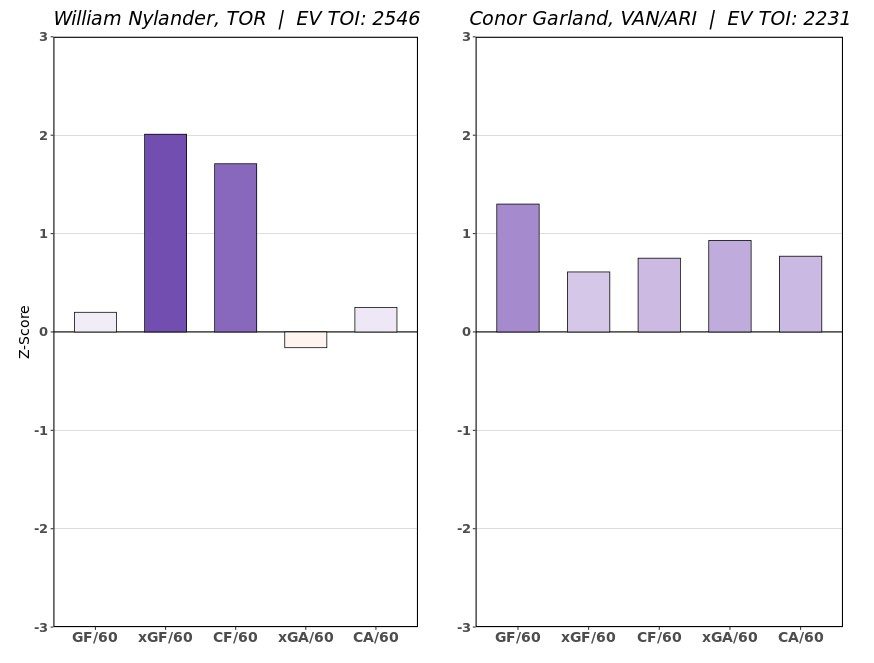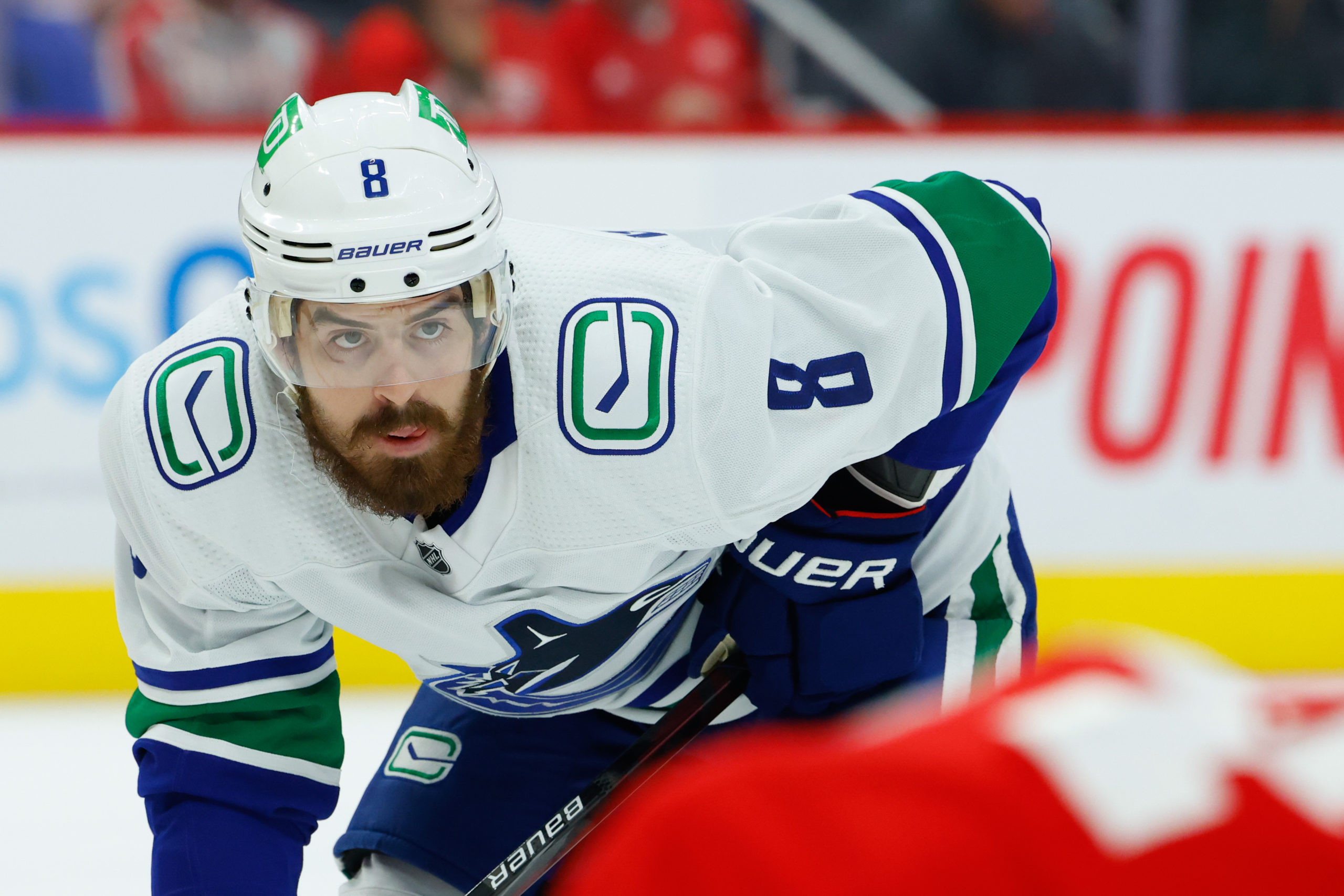Conor Garland has always been incredibly underrated. He’s listed at 5’10”, which may be generous, but all he’s ever done is produce.
Given that he’s signed for the next four and a half seasons at a reasonable $4.95 million cap hit, teams should be lining up for him if Vancouver is listening to offers. His ability to create scoring chances out of nothing, combined with his work ethic and fearlessness, make him a fan favourite.
Despite the fact that he exceeded the point-per-game mark with the Moncton Wildcats in his draft year, Garland wasn’t selected in 2014. He returned to junior and was essentially the Mitch Marner of the QMJHL:
| CHL Scoring | GP | G | A | P |
|---|---|---|---|---|
| Marner (2014-2015) | 63 | 44 | 82 | 126 |
| Garland (2014-2015) | 67 | 35 | 94 | 129 |
| Marner (2015-2016) | 57 | 39 | 77 | 116 |
| Garland (2015-2016) | 62 | 39 | 89 | 128 |
Marner put up 2.02 points per game over his final two seasons in junior, while Garland put up 1.99. Granted, Marner is a year younger than Garland and the OHL is slightly more challenging than the QMJHL, but you get the point. Arizona got an absolute steal when they picked him at the start of the fifth round just two picks before the Leafs took Dmytro Timashov.
Garland didn’t immediately make the jump to the NHL as Marner did, instead posting mediocre point totals in the AHL for two seasons. He finally broke out in his third AHL season, earning a 47-game tryout with the Arizona Coyotes. He hasn’t looked back since; in fact, his five-on-five production over the past three seasons rivals William Nylander’s.
Conor Garland vs. William Nylander
Garland and Nylander may as well be twins based on the numbers. Garland’s cap hit is about $2 million less than Nylander’s, and he’s signed for two additional seasons. If the idea of a cheaper Nylander appeals to you, you’ll like Garland.
5v5 Production Last Three Seasons
| Statistic | Garland | Nylander | A | P |
|---|---|---|---|---|
| G/60 | 1.02 | 1.02 | 82 | 126 |
| A1/60 | 0.85 | 0.85 | 94 | 129 |
| Shots/60 | 9.62 | 9.13 | 77 | 116 |
| Takeaways/60 | 2.34 | 2.49 | 89 | 128 |
If you shorten the sample to two seasons instead of three, they remain about equal in goal production, but Garland picks up a clear edge in terms of primary assists. The two players also grade out fairly similarly by Evolving Hockey‘s RAPM, with Nylander getting the edge offensively and Garland getting the edge defensively:

In terms of Evolving Hockey’s goals above replacement (GAR), Garland has outperformed Nylander in three straight seasons. Garland has posted 28.8 GAR over three seasons, while Nylander has posted 20.7.
Interestingly enough, they’re about equal if you take out Garland’s edge in even-strength offense, so Garland presumably gets more credit for his scoring production given who he plays with. Nylander has a massive edge in terms of power-play value, while Garland grades out more favourably in terms of even-strength defense and penalty differential.
Expected goals above replacement (xGAR) favours Nylander, as he’s outperformed Garland in that category in all three seasons. Nylander has posted 35.2 xGAR over this time period compared to Garland’s 26.4, but Garland jumps ahead if you take out power-play value from the equation. Since the Leafs already have four forwards for their top power-play unit, I think they’d be far more focused on even-strength production.
Garland spent most of his time playing with Nick Schmaltz and Christian Dvorak in Arizona. His next most common linemates there were Clayton Keller and Taylor Hall. This season, he’s split most of his time on the wing of either Bo Horvat or Elias Pettersson, with either Tanner Pearson or Vasily Podkolzin playing across from him.
Examining Garland’s Fit In Toronto
There are multiple ways to fit Garland into the picture for this season, but the simplest option would be to move Alex Kerfoot, likely to a third team. There are other ways, as they could potentially trade Petr Mrazek and bring in a cheap option like Anton Forsberg to replace him, but trading Kerfoot would be the likely path.
Given that Kerfoot is currently playing on the fourth line — and given that Garland is significantly better than Kerfoot — I think that’s worth considering. Garland has scored at five-on-five year after year and would be an excellent boost to the Tavares line (Nylander could shift over to the left side).
Since the 2007-08 season (as far back as the dataset goes), 643 forwards have played at least 2500 minutes. Garland sits 16th out of 643 in goals per minute at five-on-five behind only Auston Matthews, Alex Ovechkin, Jakub Vrana, Andrew Mangiapane, David Pastrnak, Jake Guentzel, Rick Nash, Steven Stamkos, Connor McDavid, Nikita Kucherov, Vladimir Tarasenko, Alex Semin, Kyle Connor, Jeff Skinner, and Sidney Crosby. He’s 29th if you look at primary points instead of goals. If you want to improve the production of your second line, he’s the guy.
Fitting him into the long-term picture is far more complicated. The Leafs likely can’t secure five years of salary retention, so they’re left trying to fit in a $5 million cap hit to an already expensive roster. They would almost certainly be trading Kerfoot, whether it’s at this year’s deadline or in the offseason, but Garland also makes about $1.5 million more than him.
The big question is: Can the Leafs have Garland on the books for next season without trading one of Nylander, Jake Muzzin, or T.J. Brodie? I believe the answer is yes, although they may end up only being able to spend five-to-six million on goaltending, and that’s assuming Rasmus Sandin and Timothy Liljegren sign for something close to their qualifying offer. Both Muzzin and Brodie have a full no-trade clause, so they probably can’t be moved even if the Leafs wanted to. They could probably create an extra million or so in cap space by trading one of Engvall or Kase and replacing them with someone on a league-minimum cap hit.
Given how tight the cap situation would be, they would likely be targeting players who make close to the league minimum. Goaltender Anthony Stolarz of the Anaheim Ducks carries a $950k cap hit for next year, while Connor Ingram of Nashville carries a cap hit of just $733k. Luke Schenn could be included in the deal with Garland, as he carries an $850k cap hit for next season. The Leafs could pay extra for salary retention for players with one season remaining like Semyon Varlamov, Vladislav Gavrikov, Carson Soucy, Damon Severson, Rudolfs Balcers, or Max Comtois.
Would they consider trading for Garland for this playoff run before potentially flipping him in the offseason? There was a rumour going around last year that the Leafs considered trading for Garland at last year’s trade deadline, with the approach that they could potentially flip him in the offseason if they couldn’t afford to extend him. Garland doesn’t carry any type of no-trade protection, so if they can’t make it work financially, they should be able to easily trade him.
The uncomfortable question here — and it’s one that many fans won’t want to hear — is this: Could it make sense to acquire Garland and trade Nylander this offseason? They’re the same age, nearly identical by the numbers, and Garland’s cap hit is $2 million less and for two extra seasons. Could Nylander net them a great defenseman or goaltender? What if Garland looks great with Tavares, but Nylander struggles down the stretch?
If the Leafs advance in the playoffs, maybe everything works out great, they keep everyone around, and then they cut costs on the edges of the roster. If they don’t, maybe they’d want to consider it. The extra $2 million in cap space could allow them to turn Kerfoot’s $3.5 million cap hit into a $5.5 million player, or Mrazek’s $3.8 million cap hit into a $5.8 million goalie. We’re not going to debate whether it’s wise or not here, but trading Mitch Marner and his $10.9 million cap hit is a real long shot.
If the Leafs can get Garland for a good price, I think they should go for it and figure the rest out later. Since he doesn’t have any no-trade protection, there isn’t a ton of risk here; they could just use him as a rental and trade him in the offseason if they needed to. The Canucks could use good and young defensemen, and players like Topi Niemela and Travis Dermott would be a good fit there, as would draft picks.
Remember: It was Jim Benning who traded for Conor Garland, not Vancouver’s current front office.






























![New Leaf Anthony Stolarz on the opportunity in Toronto: “In Florida, I knew my role as a backup… Now, [Joseph Woll] and I are competing for starts… As a goalie, that’s all you can ask for” Anthony Stolarz, Stanley Cup win, now Maple Leaf](https://mapleleafshotstove.com/wp-content/uploads/2024/07/anthony-stolarz-sc-100x70.jpg)
